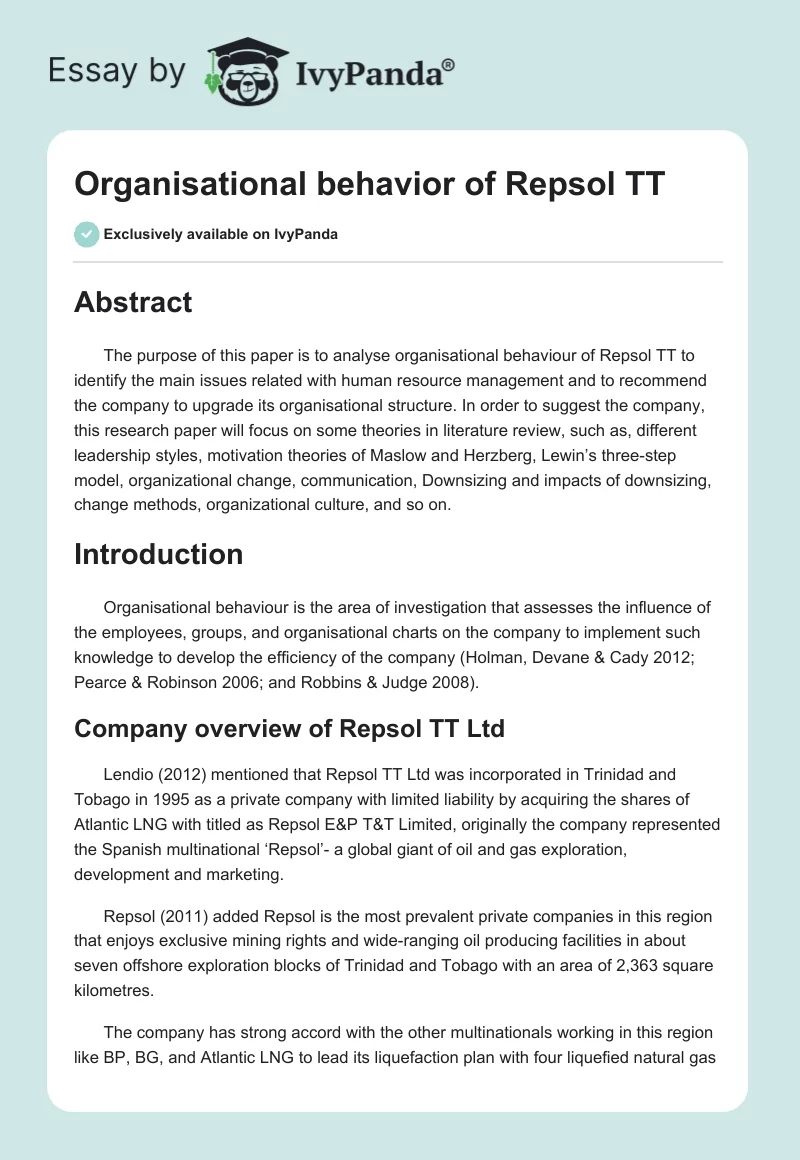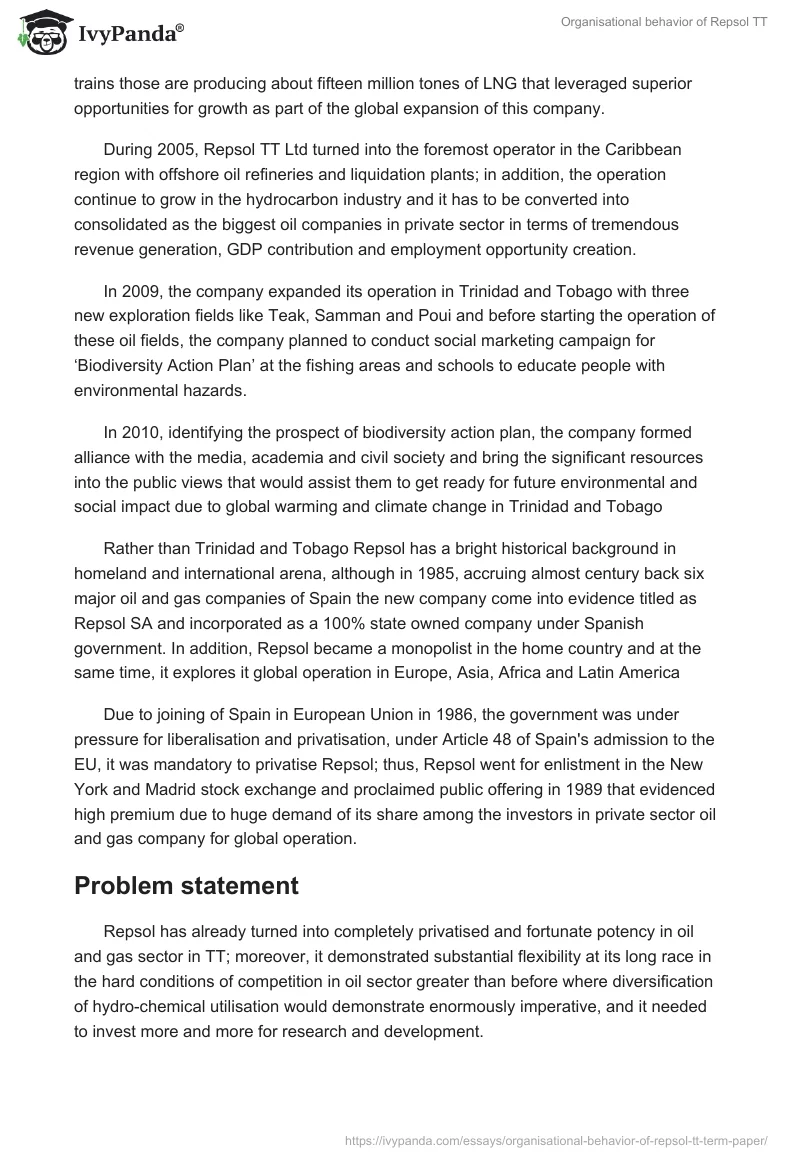Abstract
The purpose of this paper is to analyse organisational behaviour of Repsol TT to identify the main issues related with human resource management and to recommend the company to upgrade its organisational structure. In order to suggest the company, this research paper will focus on some theories in literature review, such as, different leadership styles, motivation theories of Maslow and Herzberg, Lewin’s three-step model, organizational change, communication, Downsizing and impacts of downsizing, change methods, organizational culture, and so on.
Introduction
Organisational behaviour is the area of investigation that assesses the influence of the employees, groups, and organisational charts on the company to implement such knowledge to develop the efficiency of the company (Holman, Devane & Cady 2012; Pearce & Robinson 2006; and Robbins & Judge 2008).
Company overview of Repsol TT Ltd
Lendio (2012) mentioned that Repsol TT Ltd was incorporated in Trinidad and Tobago in 1995 as a private company with limited liability by acquiring the shares of Atlantic LNG with titled as Repsol E&P T&T Limited, originally the company represented the Spanish multinational ‘Repsol’- a global giant of oil and gas exploration, development and marketing.
Repsol (2011) added Repsol is the most prevalent private companies in this region that enjoys exclusive mining rights and wide-ranging oil producing facilities in about seven offshore exploration blocks of Trinidad and Tobago with an area of 2,363 square kilometres.
The company has strong accord with the other multinationals working in this region like BP, BG, and Atlantic LNG to lead its liquefaction plan with four liquefied natural gas trains those are producing about fifteen million tones of LNG that leveraged superior opportunities for growth as part of the global expansion of this company.
During 2005, Repsol TT Ltd turned into the foremost operator in the Caribbean region with offshore oil refineries and liquidation plants; in addition, the operation continue to grow in the hydrocarbon industry and it has to be converted into consolidated as the biggest oil companies in private sector in terms of tremendous revenue generation, GDP contribution and employment opportunity creation.
In 2009, the company expanded its operation in Trinidad and Tobago with three new exploration fields like Teak, Samman and Poui and before starting the operation of these oil fields, the company planned to conduct social marketing campaign for ‘Biodiversity Action Plan’ at the fishing areas and schools to educate people with environmental hazards.
In 2010, identifying the prospect of biodiversity action plan, the company formed alliance with the media, academia and civil society and bring the significant resources into the public views that would assist them to get ready for future environmental and social impact due to global warming and climate change in Trinidad and Tobago
Rather than Trinidad and Tobago Repsol has a bright historical background in homeland and international arena, although in 1985, accruing almost century back six major oil and gas companies of Spain the new company come into evidence titled as Repsol SA and incorporated as a 100% state owned company under Spanish government. In addition, Repsol became a monopolist in the home country and at the same time, it explores it global operation in Europe, Asia, Africa and Latin America
Due to joining of Spain in European Union in 1986, the government was under pressure for liberalisation and privatisation, under Article 48 of Spain’s admission to the EU, it was mandatory to privatise Repsol; thus, Repsol went for enlistment in the New York and Madrid stock exchange and proclaimed public offering in 1989 that evidenced high premium due to huge demand of its share among the investors in private sector oil and gas company for global operation.
Problem statement
Repsol has already turned into completely privatised and fortunate potency in oil and gas sector in TT; moreover, it demonstrated substantial flexibility at its long race in the hard conditions of competition in oil sector greater than before where diversification of hydro-chemical utilisation would demonstrate enormously imperative, and it needed to invest more and more for research and development.
However, Repsol (2011) and Maroto (2012) stated that Repsol purchased total 30% of the company bpTT; therefore, it has to restructure its organisational chart to develop a suitable workplace environment for the employees as well as for the leaders of this company.
SWOT Analysis of REPSOL
Strengths
- Brand Awareness: This company has built strong brand image within short period of its operation in Trinidad and Tobago;
- Sales Volume: According to the financial statement 2010 of REPSOL, sales revenue from the products and services sales have increased from last year, which indicates this company is recovering and strengthening financial position in the market; however, the following table provides more information about profit margin of REPSOL:
Table 1: Total profit margin of REPSOL
- Technology: The success of the oil and gas exploration and marketing business largely depend on the successful installation of advance technologies with promoting innovation. In addition, development of technology help the company increase oil production; however, REPSOL always upgrades its technology;
- Development Plans: REPSOL has prepared strategic plans (the Horizon 2012) to increase assets in Libya, Bolovia and Trinidad and Tobago;
- Value Creation: This company is working to maximizing the value created for the stockholders;
- Other: Strong administrative control, future development plans, corporate social responsibility, human resource management, return on capital employed, and leadership capabilities of the Board of Directors are the key strength points of REPSOL.
Weaknesses
- Operating expenses: This company failed to control its operating expenses and it is one of the main weaknesses of this company at the present moment;
Table 1: Total profit margin of REPSOL
- Other: this company has faced many other internal problems including reserves of oil, location selection, outcomes from mergers and acquisition, measurement of reserves and so on.
Opportunities
- Market Share: 40% of its total revenue generates from the international market; therefore, it has strong financial capabilities to expand its business in the rest of the world to increase market share;
Threats
- Demand and price: According to the Financial Statement 2010 of REPSOL, crude oil demand and prices have fluctuated widely over the last 10 years. In addition, there are many factors influence the market, such as, political developments throughout the world, climate changes, strong economic growth of some developing countries, threat of terrorism and so on;
- Global Financial Crisis: Present economic position is not stable while the growth rate is only 5%; moreover, the increase in public debt all over the world may affect the business of REPSOL;
- Competitors: The presence of large competitors in the oil and gas exploration and marketing industry are one of the key threats for REPSOL while the market position of the competitors is strong enough, for instance, BP is the third largest integrated oil company and direct competitor, and Royal Dutch Shell is a competitor of REPSOL in most business areas.
Objectives of the researcher
Organisational behaviour of Repsol would help the researcher to find out the position of the employees in this organisation, job satisfaction of the employees, staff retention rate, leadership style, financial position of the company in the recessionary economy to assess whether it should require organisational change or not to gain competitive advantage over competitors.
Literature Review
Leadership and motivation
The theory of leadership and motivation are interrelated with each other and both factors influence the employees to perform in their workplace (Robbins & Judge 2008; Hitt, Ireland & Hoskisson 2001; and Solomon, Bamossy & Askegaard 2001).
However, there are many leadership theories to control the organisation, such as, great man theory, trait theory, behavioural and contingency theory, participative leadership style, autocratic leadership style, situational leadership style, transactional leadership style, transformational leadership style, and so on (Rowstrom 2011; Robbins & Judge 2008; Johnson, Seholes & Whittington 2006; and Solomon, Bamossy & Askegaard 2001). However, Lewin (1939) categorized leadership styles in three groups –
- Autocratic Leadership: This is a traditional approach where leaders enjoyed ultimate power in case of decision-making and implementation of the strategies without consulting with staff (Cherry 2012; and Lewin 1939); therefore, subordinates or team members are bound to follow the decision of the top management (Robbins & Judge 2008; and Weihrich & Koontz 2005). In addition, the leaders not take any feedback of the employees considering the fact that they have vast knowledge and better understanding, which is one of the prime factors to become less effective and attractive to govern the organizations of developed countries in this way;
- Participative Leadership Style: On the other hand, Lewin (1939) also pointed out the democratic leadership style, which is more relevant to the modern firms where the leaders inform the employees about their plans and consider the feedback of the employees to take decision and execute the strategies. In addition, this style motivates the employees to take part in decision-making along with problem solving (Robbins & Judge 2008; Lewin 1939; Johnson, Seholes & Whittington 2006; and Nader 2012).
- Delegative (Laissez-Faire) Leadership: It is also known as the “hands-off¨ style and this style gives the opportunity to the employees to take their decision using discretionary power and perform their own way.
Leadership styles
Robbins & Judge (2008) defined Leadership as the ability to influence a group toward the achievement of a vision or set of goals; Kotler & Armstrong (2006), Pitt (2001) and Pearce & Robinson (2006) stated the sources of this influence may be formal, but organizations need strong leadership and strong management for optimal effectiveness.
However, Robbins & Judge (2008), Pitt (2001), Rowstrom (2011) and Pearce & Robinson (2006) further added that strong leadership is important to create visions of the future and to inspire the employees to gain competitive advantage over the competitors and reach its goals within the desired time limit.
Transformational
This leadership approach is opposite to the transactional leadership (Robbins & Judge 2008; and Pearce & Robinson 2006); however, this approach improves the motivation, confidence and performance (Johnson, Seholes & Whittington 2006). According to this method, leaders motivate the subordinates to perform the required task with their self-interest for the welfare of the company (Robbins & Judge 2008; Katzenbach & Douglas 2000; and Pearce & Robinson 2006).
However, this approach is very motivating for the employees who work with the transformational leader because leaders pay attention on the developmental needs of the employees and help them accordingly to achieve the vision of the company (Robbins & Judge 2008; and Pearce & Robinson 2006).
Organizational change
Multinational companies face a dynamic and changing environment due to advancement of technology, or execution of business expansion plan, or compete with the competitors in such global economic position (Pearce & Robinson 2006; Kotler & Armstrong 2006; and Robbins & Judge 2008).
For instance, Repsol needs to consider the issue of organizational change while it would like to expand its business or purchase the share of other companies or adopt new technologies, for example, it incorporated in Trinidad and Tobago in 1995 and purchased 30% shares of BPTT, which influenced the company to change its organisational structure.
Organizational Culture
It refers to a system of shared meaning held by members that distinguish the organisation from other organisation and it includes some features that the organisation values, for instance, the degree to which staff are encouraged to be innovative, and to exhibit precision, people’s orientation, team orientation, aggressiveness, and stability (Robbins & Judge 2008; and Pearce & Robinson 2006).
A leading culture gives an organisation its distinct personality and it conveys the core values that are shared by a most of the employees of the company; however, in as strong culture, the company’s core values are both intensely held and widely shared (Robbins & Judge 2008; Johnson, Seholes & Whittington 2006; Porter 2004; and Pearce & Robinson 2006). However, they further added that good organizational culture should include –
- Empowering employees
- Having a team orientation
- Having a clear strategic direction and intent
- Possessing a strong and recognizable vision
At the same time, culture performs many function within a company, such as –
- It has a boundary-defining role;
- It creates distinctions between one organisation and others (Hitt, Ireland & Hoskisson 2001; and Weihrich & Koontz 2005);
- It develops the stability of social system (Rowstrom 2011);
- It serves as a sense making and control system to guide employees (Robbins & Judge 2008; and Pearce & Robinson 2006).
Communication
Communication plays vital role in the organisation to control, motivate, and give information to the employees; however, communication takes place in various forms including formal and informal, verbal and nonverbal those need to use according to the situation (Robbins & Judge 2008; Pitt 2001; Rowstrom 2011; Weihrich & Koontz 2005; and Pearce & Robinson 2006).
Moreover, effective communication is necessary to convey the visions, goals, and values of the organisation to make flexible the decision-making process to achieve the objectives (Robbins & Judge 2008; and Katzenbach & Douglas 2000); however, there are mainly three methods of communication, such as, oral, written and nonverbal communication (Johnson, Seholes & Whittington 2006; and Solomon, Bamossy & Askegaard 2001).
According to the Repsol (2010, p.86), transparency and close relations with the different stakeholders of the company are the basis of communications policy of this company, for instance, shareholders and investors are now able to access all sorts of information to know about the day-to-day business and at present, it has 41 analysts monitoring the performance of the company.
At the same time, consolidated management report of Repsol (2011, p.86) also mentioned that shareholders can ask for any information to the officials by telephone, email or by post, for example, officials received more than 52,000.0 calls in 2010 and most inquiries concerned the share price, dividend policy, and other financial issues.
Change Method of Organizational Behaviour
Booth (1996) added that the attempt to build up a sensible and participatory method to bring evidence of changes in behaviour of targeted group or communities would promote the sustainable utilization of managerial resources for which the organization has struggled for long-term Change Method is the tested and accepted methodology in this context beneficial for the literature of Organizational behaviour.
Organizational Transformation
Orlikowski (1995) designed a point of view on organizational transformation that carry out change as a prevalent practice to sort out the situated practices of organizational leaders to improve, innovate, and regulate their regular duties with the substantially of shifting the organizational configuration with standardization control and IT technology adoption
Lewin’s Three-Step Model
Kurt Lewin pointed out that successful change in firms should pursue three steps, for instance, unfreezing the status quo, movement to a desired end state, and refreezing the new change to make it permanent; however, the following figure give more information in this regards –
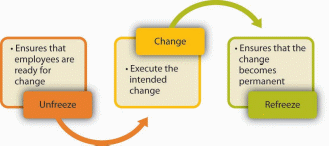
- Unfreeze: the purpose of this step is to ensure right environment for change to overcome the pressures of both individual resistance and group conformity;
- Movement: Good leadership is essential criteria because change is central point to this model and at the psychological level (Robbins & Judge 2008, p.651);
- Refreeze: The final objective of the model is to get a ‘refreeze’, re-establishing a new place of stability and raise comfort levels by reconnecting the employees back into their safe, and familiar environment (Pearce & Robinson 2006)
According to the consolidated management report Repsol (2010, p.86).

Downsizing
Steed (2011) reported in the Telegraph that the strategy of downsizing to develop organisational competence in terms of productivity and to reduce operating expenses might create a number of problems including waste of money of the organisations.
Rinefort, Fleet & Fleet (1998) argued that downsizing has become a popular strategy to the modern business world because this system increases the span of the management and decrease administrative costs; therefore, large multinational companies like General Motors, Northern Telecom, Avon, etc. had followed this strategy considering their financial position and other external and internal factors.
However, Repsol has implemented this strategy in Argentina to protect the company from labour movement (Carlson 2002); in addition, Repsol has also considered this strategy in other zone to save the company from the adverse economic impact though it has no current plan to adopt this strategy in Trinidad and Tobago.
Impacts of downsizing
Many scholars like Mellahi & Wilkinson (2012), Rinefort, Fleet & Fleet (1998) and Carlson (2002) pointed out that downsizing is one of the most popular strategies because of enhancing organizational efficiency, falling expenditure and recovering organizational performance, but surprisingly its impact on several organizational outcomes remain ambiguous.
However, the researchers stated that downsizing strategy demoralize the employees as it has seriously enlarged their job insecurity; in addition, this strategy affects on the global operation of the multinationals (Mellahi & Wilkinson 2012; Robbins & Judge 2008; and Hitt, Ireland & Hoskisson 2001).
Maslow’s Hierarchy of Needs Theory
This theory has established by Abraham Maslow that plays a vital role to motivate the human resources; however, this theory pointed out that every member of the organization has mainly five levels of needs that require fulfilling chronologically and fulfilment of one give raise to another – this theory has demonstrated in the following figure:
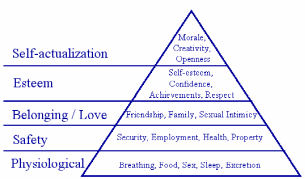
Herzberg’s Two-Factor Theory
Herzberg (2003) had tried to find out what do the employees want from their jobs and interviewed 200 respondents to assess when they felt good or bad about their jobs; however, the following figure discuss this issue more elaborately –
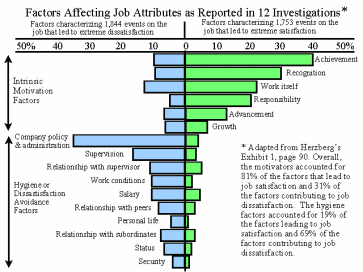
This is one of the most popular, but controversial theory because he did not provide overall measure of satisfaction, and this theory is inconsistent with previous research and the research is overlooked the issue of productivity.
Methodology
Primary data collection
Malhotra (2009) pointed out that gathering primary data is essential for the explicit motive or determine the research problem; therefore, the researcher of this study would prepare a structured questionnaire to collect primary data from the employees of the REPSOL TT; however, the target respondents must have five years experience to work for this company.
Secondary data collected
Cohen, Manion and Morrison (2007) stated that secondary data analysis is important because these data have already published and recognized by the renowned authors; however, the researcher of this paper would consider a number of books and journals related with organisational behaviour, and also use internet sources like corporate governance report, consolidated financial statement 2010 of REPSOL, and sustainability plan.
According to the opinion of Zikmund (2006) and Saunders, Thornhill & Lewis (2006), secondary processed data are more reliable to analyze the present task; therefore, the researcher also consider several reports of the scholars regarding the organizational structure of REPSOL and the competitors, leadership styles, equal opportunity, cultural factors, internal environments of REPSOL to work, and so on.
Limitation of the Research
- Limited word limits to cover all issues related with organizational behaviour of REPSOL;
- Shortage of deadline to complete the paper;
- Unwillingness of the employees of REPSOL to give their feedback on time; and
- Identification of proper relevant secondary resources was another limitation to organise the study; and
- Limited scope of data analysis
Analysis methods
The researcher of this paper would follow qualitative research approach to organise the paper and he would prepare a questionnaire with open questions and interviewed to the target employees of Repsol, which gives the opportunity to the researcher to discuss more details in descriptive manner about the organisational behaviour of Repsol in Trinidad and Tobago.
Analysis
Respondent’s view about leadership style of Repsol
- Autocratic leadership style: this type of leadership style does not applicable for REPSOL TT as it is one of the largest oil companies in Trinidad and Tobago, which needs to motivate the staff using different policies and to take many technical decisions where the opinion and feedback of efficient employees play vital role in decision-making;
- Participative Leadership Style: However, respondents pointed out the view of Repsol (2011) and Maroto (2012) and stated that the International consulting firm Hay Group has performed an investigation and recognised Repsol as the best European energy company for leadership because leaders of this company helps the employees to perfectly balance family and work life to attract and maintain professional talent
Respondent’s view about motivational factors of Repsol
Most of the respondents argued that the leaders motivate the employees to reach the objectives of the company and they are satisfied with the attitude of the leaders; in addition, they mentioned that Repsol is the best company for leadership as the company follows effective motivational tools.
Respondent’s view about communication factor of Repsol
According to the respondents, the company is currently maintaining quite efficient communications with its employees though only 1% employees come from Trinidad and Tobago
Respondent’s view about organisational change of Repsol
The respondents suggested that it is crucial for Repsol to follow Lewin’s three- step change method
Recommendations and Conclusion
Recommendations
- As REPSOL TT is the owner of 30% share of BPTT, it should restructure the organisational structure to create better working environment;
- At the same time, it should require to modify job responsibilities for the new working environment;
- In addition, the leader of REPSOL should follow democratic leadership approach instead of Autocratic approach to motivate the employees;
- The management should arrange training programme for the employees to work as a team and develop communication skills, which will help the company to increase job satisfaction and reduce staff tu8rnover and other internal problems;
- It would ensure equal opportunity and never discriminate between men and women in case of job facilities;
- However, it must reform appointment process time-to-time to select the best competent person for the posts;
- Safety, people and performance are the top priorities of this company; therefore, it should ensure workplace safety and compensate properly for injury as a part of its social responsibility;
- Most of the oil company is committed to pay compensation if any incident occur, but practically these companies try to evade by applying various mechanism; for instance –the management can argue that we are operating Trinidad and Tobago, but our parents company liable for the fault;
- However, oil and gas exploration companies mainly concentrate on maximize the profit margin without focusing ethical issues; so, REPSOL should follow ethical code of conducts in order to develop organisational culture, and ensure safety for all irrespective of race, ethnic minority and so on
Conclusion
It is important to note that Repsol is currently in stable condition from the overall business perspective; as a result, it does not require any massive organisational change at present. However, the company needs to focus on the issue of increasing the number of employees from Trinidad and Tobago, because only one percent employees from this country create communication problem and other crisis.
Moreover, it is also essential for the company to focus on its techniques towards administration by further concentrating on Maslow’s approach of management and other theories.
Reference List
Booth, E. M 1996, Starting with Behaviour. Web.
Carlson, B. A 2002, Job losses, multinationals and globalization: the anatomy of disempowerment. Web.
Cherry, K. 2012, Lewin’s Leadership Styles, Web.
Cohen L., Manion, L., & Morrison, K 2007, Research Methods in Education, Routledge, New York.
Herzberg, F 2003, ‘One more time: How do you motivate employees?’, Harvard Business Review. Web.
Hitt, M. A., Ireland, R. D., & Hoskisson, R. E. 2001, Strategic Management, Thomson Learning, South-Western.
Holman, P., Devane, T., & Cady, S. 2012, Change Methods: Seven Basic Characteristics, Web.
Johnson, G., Seholes, K., & Whittington, R. 2006, Exploring Corporate Strategy: Text & Cases, FT Prentrice Hall, London.
Katzenbach, J. R. & Douglas, S. 2000, The Wisdom of Teams: Creating the High-Performance Organization, Harperbusiness, London.
Kotler, P. & Armstrong, G. 2006, Principles of Marketing, Prentice-Hall of India Private Limited, New Delhi.
Lendio 2012, Repsol S.A. Company History, Web.
Lewin, K 1939, ‘Patterns of aggressive behaviour in experimentally created social climates’, Journal of Social Psychology, vol. 10 no. 2, p.271.
Malhotra, N. K 2009 Marketing Research- An Applied Orientation, Prentice-Hall of India Private Limited, New Delhi.
Maroto, M. D 2012, Analyzing Repsol, Web.
Mellahi, K. & Wilkinson, A. 2012, Slash and Burn or nip and tuck? Downsizing, Innovation and Human Resources. Web.
Nader, R 2012, Leadership and Motivation. Web.
Orlikowski, W. J 1995, Improvising Organizational Transformation Over Time: A Situated Change Perspective, Web.
Pearce, J. A. & Robinson, R. B 2006, Strategic Management. 8th ed. London: McGraw-Hill.
Pitt, D. C 2001, ‘Leadership and Motivation: The Effective Application of Expectancy Theory’, Journal of Managerial Issues, vol. XIII no. 2, Web.
Porter, M. E 2004, Competitive Strategy, The Free Press, New York.
Repsol 2010, Consolidated Financial Statements of REPSOL, Web.
Repsol 2010, Consolidated Management Report of Repsol, Web.
Repsol 2011, Our History, Web.
Repsol 2011, Repsol: Best European Energy Company for Leadership, Web.
Repsol (2012) Organisational structure of Repsol, Web.
Rinefort, F. C, Fleet, R. D. D & Fleet, E. W 1998, ‘Downsizing: A Strategy that may be Hazardous to Your Organization’s Health’, International Journal of Management, vol. 15 no. 3. Web.
Robbins, P. S. & Judge, A. T 2008, Essentials of Organizational Behaviour, Pearson Prentice Hall, London.
Rowstrom, J. W 2011, Organizational Behaviour: Human Behaviour at Work, The McGraw-Hill Companies, London.

